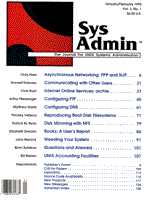
Sidebar: Resource Records
Data for DNS is coded in standard resource record format. A line of data in this format is called a resource record (RR). Resource records have the format:
(owner) (time-to-live) class type RDATA
The owner is the domain (or entity) that owns the record. If this field is blank, ownership defaults to the last owner specified. The Time-To-Live (TTL) is a value (expressed in seconds) that indicates how long this data record may be cached. A value of zero indicates that caching is not allowed (probably not a good idea). If the field is left blank, the TTL is set to the minimum value specified in the SOA record. In most DNS applications, the class will be IN, for the Internet system (but it can also be CH for the Chaos system). Type defines the type of data being represented. Type may be one of the following: A -- Address record. Maps a name to a TCP/IP address. NS -- Nameserver record. Designates a machine that will serve as namewerver. SOA -- Start of Authority record. Declares that a nameserver will have authority over a given domain. MX -- Mail Exchange record. Declares that a specific machine is the mail exchange machine for the domain. PTR -- Pointer record. Points to a domain name or an address-to-name mapping. RDATA is the data for the record. For an SOA record the data consists of the e-mail address of the system manager and five numeric parameters which will be read by secondary nameservers. For an NS record, the data is the name of the nameserver. For an A record, RDATA is a standard TCP/IP address. All addresses in the resource record format end with a dot (.). Without a trailing dot, the nameserver will append the current zone (or $origin, if defined) to the end of the owner field. In Figure 7, if the "discovery" entry were coded without a trailing dot, the entry would be built as discovery.chq.sinag.com.chq.sinag.com. This is a common misconfiguration and can easily be spotted with a dump of the database.
|